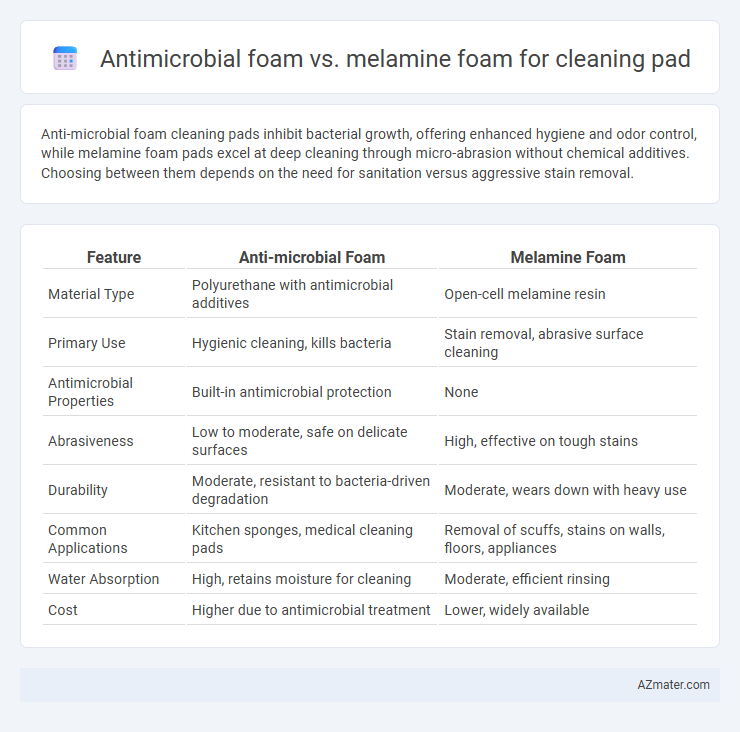Anti-microbial foam cleaning pads inhibit bacterial growth, offering enhanced hygiene and odor control, while melamine foam pads excel at deep cleaning through micro-abrasion without chemical additives. Choosing between them depends on the need for sanitation versus aggressive stain removal.
Table of Comparison
| Feature | Anti-microbial Foam | Melamine Foam |
|---|---|---|
| Material Type | Polyurethane with antimicrobial additives | Open-cell melamine resin |
| Primary Use | Hygienic cleaning, kills bacteria | Stain removal, abrasive surface cleaning |
| Antimicrobial Properties | Built-in antimicrobial protection | None |
| Abrasiveness | Low to moderate, safe on delicate surfaces | High, effective on tough stains |
| Durability | Moderate, resistant to bacteria-driven degradation | Moderate, wears down with heavy use |
| Common Applications | Kitchen sponges, medical cleaning pads | Removal of scuffs, stains on walls, floors, appliances |
| Water Absorption | High, retains moisture for cleaning | Moderate, efficient rinsing |
| Cost | Higher due to antimicrobial treatment | Lower, widely available |
Introduction to Cleaning Pads: Anti-Microbial Foam vs Melamine Foam
Anti-microbial foam cleaning pads offer effective resistance against bacteria, mold, and mildew, enhancing hygiene in various cleaning applications. Melamine foam cleaning pads excel in removing tough stains and dirt with micro-abrasive properties, making them ideal for deep cleaning on multiple surfaces. Choosing between anti-microbial foam and melamine foam depends on the specific cleaning needs, hygiene requirements, and material compatibility.
Composition and Structure: Anti-Microbial vs Melamine Foam
Anti-microbial foam is composed of polyurethane infused with agents that inhibit bacterial growth, providing hygienic cleaning surfaces resistant to microbial contamination. Melamine foam, made from a rigid, cross-linked melamine resin, features an open-cell structure with microscopic hard fibers that enable deep dirt and stain removal through abrasive action without added chemicals. The anti-microbial foam's softer texture prevents surface scratches, while melamine foam's unique micro-structure offers superior cleaning efficiency on tough stains and textured surfaces.
Anti-Microbial Properties: How Effective Are They?
Anti-microbial foam for cleaning pads incorporates agents that inhibit bacterial, fungal, and viral growth, significantly reducing surface contamination during cleaning tasks. Melamine foam, while highly effective for removing dirt and stains through its microstructure, lacks inherent anti-microbial properties and does not prevent microbial proliferation. Studies show anti-microbial foam can achieve up to 99.9% reduction in microbial colonies, making it superior for hygiene-critical applications compared to traditional melamine foam.
Cleaning Performance: Stain and Dirt Removal Comparison
Anti-microbial foam offers superior stain and dirt removal due to its embedded antimicrobial agents that inhibit bacterial growth and enhance cleaning efficiency. Melamine foam excels at removing tough stains and grime through its micro-abrasive structure, effectively trapping and lifting dirt without harsh chemicals. Comparing performance, anti-microbial foam provides prolonged hygiene benefits for cleaner surfaces, while melamine foam delivers strong physical cleaning power for immediate dirt and stain removal.
Durability and Longevity of Cleaning Pads
Anti-microbial foam cleaning pads offer enhanced durability by resisting bacterial growth, which extends their lifespan compared to standard melamine foam pads. Melamine foam, known for its effective dirt removal due to microstructure, tends to degrade faster with frequent use, reducing longevity. Choosing anti-microbial foam results in longer-lasting cleaning pads that maintain hygiene and structural integrity over time.
Safety Concerns: Health and Environmental Impact
Anti-microbial foam cleaning pads inhibit bacterial growth, reducing the risk of cross-contamination and promoting safer usage in healthcare and food service environments. Melamine foam, while effective for stain removal, may release fine particles during use, raising concerns about respiratory irritation and environmental pollution due to non-biodegradable waste. Prioritizing anti-microbial foam enhances user safety by minimizing microbial hazards and supports environmental sustainability through reduced harmful emissions and improved biodegradability.
Cost-Effectiveness: Price vs Cleaning Value
Anti-microbial foam cleaning pads offer enhanced hygiene benefits by inhibiting bacterial growth, often at a higher price point compared to standard melamine foam pads. Melamine foam pads deliver effective cleaning performance and stain removal capabilities at a lower cost, making them a budget-friendly option for routine cleaning tasks. Evaluating cost-effectiveness involves balancing the premium cost of anti-microbial foam with its added health benefits against the affordability and proven cleaning efficiency of melamine foam.
Suitable Applications: Where Each Foam Excels
Anti-microbial foam is ideal for cleaning environments requiring bacteria resistance and hygiene control, such as hospitals, kitchens, and bathrooms, effectively minimizing microbial growth while cleaning. Melamine foam excels in removing tough stains and dirt from hard surfaces like walls, tiles, and electronics due to its micro-porous structure that physically scrubs without harsh chemicals. Choosing the right foam depends on the need for microbial protection versus abrasive cleaning strength for specific cleaning tasks.
Maintenance and Care Recommendations
Anti-microbial foam cleaning pads require gentle hand washing with mild soap and air drying to maintain their bacteria-resistant properties and extend lifespan, avoiding harsh chemicals or machine drying that can degrade the foam structure. Melamine foam pads should be rinsed thoroughly after each use to remove debris, allowed to dry completely to prevent mold growth, and replaced regularly as they wear down due to their abrasive nature. Proper maintenance of both foams ensures optimal cleaning performance and durability, with anti-microbial foam emphasizing preservation of its germ-resistant coating and melamine foam focusing on preventing physical breakdown.
Conclusion: Choosing the Right Cleaning Pad for Your Needs
Anti-microbial foam cleaning pads offer enhanced protection against bacteria and mold, making them ideal for hygienic environments such as kitchens and healthcare facilities. Melamine foam excels at removing tough stains and grime without harsh chemicals, perfect for delicate surfaces and everyday cleaning tasks. Selecting the right cleaning pad depends on your specific needs: prioritize anti-microbial foam for sanitation and microbiological safety or melamine foam for effective, chemical-free stain removal.

Infographic: Anti-microbial foam vs Melamine foam for Cleaning pad
 azmater.com
azmater.com